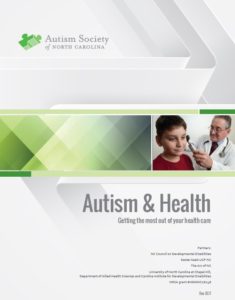The Autism Society of North Carolina held its 2018 annual conference March 23-24 in Charlotte. We will be sharing information from conference presentations in upcoming blog posts.
Mindy Govan and Alicia DiDomizio, the Director and Assistant Director of ASNC’s IGNITE program for young adults on the spectrum, provided conference attendees with many tips they could use to build healthy habits for their loved ones or themselves.
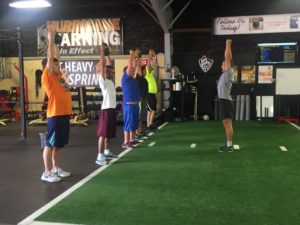
IGNITE members stretch at Champions
They began their presentation, titled “Teaching Healthy Habits: Exercise, Nutrition, Wellness, and Personal Goal Setting,” with some sobering facts about individuals on the spectrum. Physical activity can be challenging for individuals with autism because many struggle with motor skills, hand-eye coordination, and balance. According to the CDC, adults with disabilities who get no physical activity are 50% more likely to have diabetes, stroke, heart disease, or cancer than those who get the recommended amount of physical activity.
In addition to overall improved health, some of the benefits of exercise include better mood, improved concentration and creativity, and reduced stress and anxiety, Govan said. Physical activity also improves sleep, something that individuals on the spectrum often struggle with and that in turn affects their mood and functioning.
Govan then shared some guidelines from the World Health Organization: Physical activity is any movement, not just sports, but moderate to vigorous activity brings benefits. It is recommended that people 5-17 years old get 60 minutes of activity per day and adults get 150 minutes per week.
Get moving for better health
Given all of that, how do we help our loved ones on the spectrum increase their physical activity? First, we must take into account their level of receptive language and how they communicate, which activities they already do and enjoy, any sensory issues, their special interests, and the types of items or activities that are rewarding. Then we can build on what they are doing, provide direction they can follow, and motivate them to enjoy activities that are beneficial.

IGNITE members play miniature golf
Technology can be a huge help, Govan pointed out. Fitbits can remind you to get up and move, track steps and calories, and even count swimming laps. Pokémon GO incorporates a special interest for many individuals on the spectrum as it inspires them to move about. And of course, many smartphone apps are available for tracking exercise, which can motivate individuals who are competitive or striving for a certain level to attain a reward.
Sensory issues can be a barrier to physical activity, Govan said. Heat, noise, and lights in a gym, outside, or wherever we choose to exercise can be intolerable for some. At IGNITE, they overcame this by starting exercise programs at the community center, a controlled and known setting. After individuals became comfortable with the exercise routine, they could then move to a gym for sessions.
Expanding current activities that they enjoy can be an easy way to increase physical activity. Do they enjoy riding a bicycle? Lengthen rides by going to greenways or make them more frequent by taking bikes for errands. Do they love animals? Go to a zoo that requires lots of walking, like the NC Zoo in Asheboro. Do they love sports? Have them join Special Olympics or a recreational team in your town or take a tour of the athletic stadium for their favorite team. Do they climb on your furniture? Go to a climbing gym.
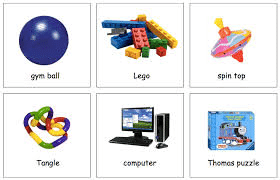
A choice board for activities
Help your loved one feel in control of their physical activity, and therefore more willing to participate, by providing choices. Exercise may not be a choice, but which activity they do can be. Variety also prevents boredom and burnout. For those who do not communicate verbally, create choice boards using objects, photos, icons, or words.
Also be sure to use structure whenever possible. Map out the zoo so they know how far they are going. Count repetitions of an exercise on the way to a goal number. When you provide structure, the individual knows what is going to happen, how long it will last, and when it is finished.
Structure also allows you to set goals and possibly provide rewards when they hit them, thereby motivating the individual. Some healthy ideas for rewards include special interest sticker charts, special outings, or time with a favorite person.
Another way to increase exercise is by sneaking it in, Govan said, providing the following ideas:
- A day at the pool or beach
- A family camping trip
- Dancing to favorite music
- Wii games
- Parking far from store entrances to increase walking
Taking control of health
For better health, individuals with autism also need to learn how to take care of themselves, Govan said. For many of them, their parents have taken the lead in their medical care, and that habit extends longer than it needs to for some.
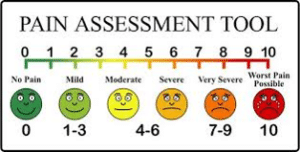
A visual can help explain pain
First, individuals must learn to communicate symptoms that they are experiencing. Parents can teach them by using visual aids. With cuts and scrapes this is easy: they can see the injury, and parents can put a bandage on it and tell them it will be all better. But how can we teach individuals with autism to communicate something like a stomachache? Govan recommends using the same bandage, teaching them to place it where they feel pain, even if that is somewhere like their forehead for a headache. When the level of pain needs to be communicated, she recommended using a simple scale with fewer levels. A range of smiley and frowny faces can also help them convey how they feel.
For younger children, a visual support can make doctors’ visits go more smoothly. (The free ASNC toolkit Autism & Health provides a sample schedule and a social narrative that can help with this, as well as many other helpful resources.)
Some individuals may be able to learn about diagnosing their own illness, and this starts with the thermometer. Beyond learning how to take their own temperature, they must learn how to interpret the results. At what temperature should they take medicine or go to a doctor? In the case of injury (to themselves or others), individuals may need to be taught to seek assistance. They need to know at what level they should take care of it themselves, go to a doctor, or call 911. If they need to call 911, they should know which information to provide. Scenario cards that you use before anything happens can be useful in teaching all of these important life skills.
To live independently and maintain health, individuals also should know about their allergies, how to read a medicine label, basic types of medicine and when to use them, and how to care for wounds and burns, Govan said. Finally, they should have a contact list for their doctor(s) and understand recommended preventative health care. Parents can help by providing a medical history sheet that individuals can use to fill out forms at doctors’ visits.
Better nutrition for better health
Healthy eating habits can also be challenging for individuals with autism. Because they are sensitive to textures, many are picky eaters, eating limited foods such as chicken nuggets and pizza. They may not eat enough food, suffer from constipation, or be at risk for medication interactions.
The first step toward nutrition is to monitor what your loved one is eating, DiDomizio said. A simple written food log can do this, but smartphone apps are also available for those who enjoy technology. Don’t forget to keep an eye on portion size.
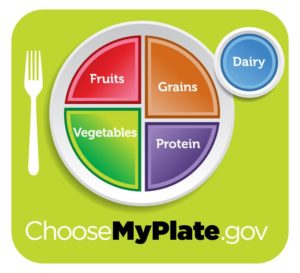 Visual supports can help individuals eat more healthy foods. Choosemyplate.gov shows the five food groups in their recommended ratios: vegetables, grains, fruits, protein, and dairy. The website also provides daily checklists, tips for increasing desired groups, and lists of foods within each group.
Visual supports can help individuals eat more healthy foods. Choosemyplate.gov shows the five food groups in their recommended ratios: vegetables, grains, fruits, protein, and dairy. The website also provides daily checklists, tips for increasing desired groups, and lists of foods within each group.
Keeping a routine schedule and environment for mealtimes can also help, DiDomizio said. Professional guidance should be sought for special diets or to assist in improving nutrition.
To help individuals with autism become more involved in their own nutrition, give them some control while encouraging them to try new foods. Let them plan meals for the week, pick out healthy recipes, and help with the shopping. Teach them about cooking and food safety and allow them to prepare their own meals. At IGNITE, the young adults have been more excited about trying new foods that they have prepared themselves, DiDomizio said.
Set goals for overall wellness
To wrap up, Govan and DiDomizio discussed helping your loved one set goals for better health. A previous blog post describes how they do that using the SMART technique at IGNITE.
Mindy Govan is the Director of ASNC’s IGNITE program. She has been a certified TEACCH clinician, trainer, consultant, program developer, and coach. Ms. Govan has created and facilitated social skills groups for high school and university students, worked with young adults individually on strategies and skill-building, and developed and facilitated parent support groups.
Alicia DiDomizio is the Assistant Director of ASNC’s IGNITE program. She graduated from East Carolina University with a BS in Special Education. She has worked as a special education teacher and community skills instructor and has been instrumental in helping to develop and implement many of the programs and groups at IGNITE.
Tags: Annual Conference, ASNC, autism, autism asperger parenting tips, autism behavior, autism education, autism exercise, autism health, autism health care, autism society north carolina, autism society of NC, Autism Society of North Carolina, Autism spectrum, Autism Spectrum Disorder, Autism Spectrum Disorders, autism support

